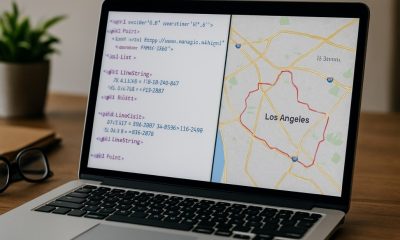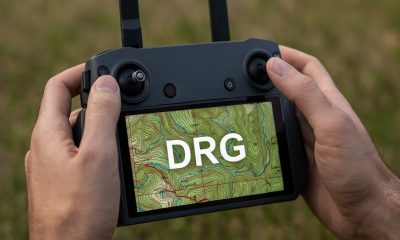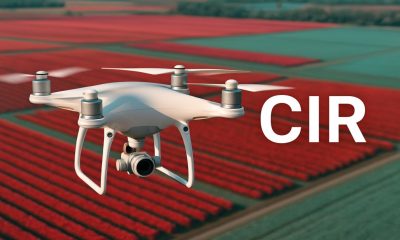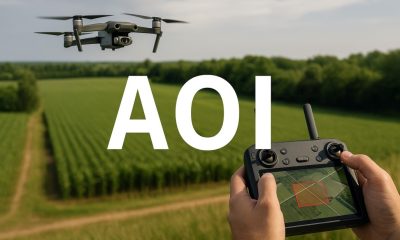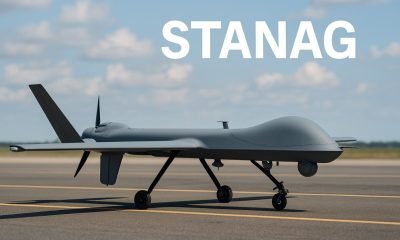- Acronym Guide
- AAM
- ABS
- AC
- ACAS
- ADS-B
- AFAC
- AGL
- AI
- AIM
- ALS
- AM
- AMA
- ANSP
- AOI
- APPI
- AUV
- AUVSI
- ARPAS-UK
- ASTM
- ATC
- BVLOS
- CAA
- CAAC
- CAB
- CASA
- CATT
- CBO
- CBR
- CBRN
- CDMA
- CDR
- CFR
- CIR
- COA
- COMINT
- CORS
- COTP
- COTR
- CPTED
- CV
- C2
- DAA
- DEM
- DFI
- DFS
- DGCA
- DHS
- DOD
- DPA
- DPEs
- DRG
- DRO
- DSM
- DSMX
- DSP
- DSSS
- DTM
- EASA
- EFT
- EO
- EOD
- EO/IR
- ELINT
- EMI
- ESC
- EVLOS
- eVTOLs
- FAA
- FCC
- FCS
- FHSS
- FICCI
- FLIR
- FOB
- FOV
- FPS
- FPV
- GBDAA
- GCP
- GCS
- GDPR
- GML
- GNSS
- GPS
- GSD
- GVC
- HDR
- HOGE
- IACRA
- ICAO
- ICS
- IMU
- INS
- IR
- ISA
- ISR
- ITU
- JARUS
- LAAMS
- LAANC
- LAATM
- LAI
- LBA
- LIDAR
- LOS
- LSALT
- MAC
- MAVLink
- MLIT
- MMS
- MSL
- MTOM
- NDAA
- NCSL
- NFZ
- NIST
- NMEA
- NOTAM
- NPA
- NPRM
- NTIA
- OBIA
- OEM
- OFDM
- OOP
- PASM
- PAV
- PCV
- PdM
- PEC
- PIC
- PID
- PIPL
- PLD
- PM
- PN
- PPK
- PPS
- PSM
- PWM
- UAM
- UAOP
- UAS
- UASTM
- UAV
- UCAVs
- UHD
- UHF
- USV
- UTM
- RAIM
- RCC
- RCS
- RFI
- ReOC
- RePL
- RMS
- ROI
- RPAS
- RPC
- RTH
- RTK
- SaR
- SAR
- SARP
- SBAS
- S.Bus
- SBIR
- SEDENA
- SfM
- SFOC
- SIGINT
- SLAM
- SMS
- SORA
- STANAG
- STTR
- sUAS
- TCAS
- TCCA
- TFR
- TIN
- TOF
- TP
- TPS
- TSA
- VHF
- VLOS
- VTOL
Drone Acronyms
What is VLOS (Visual Line of Sight) & How Does it Work?
By
Jacob StonerTable Of Contents
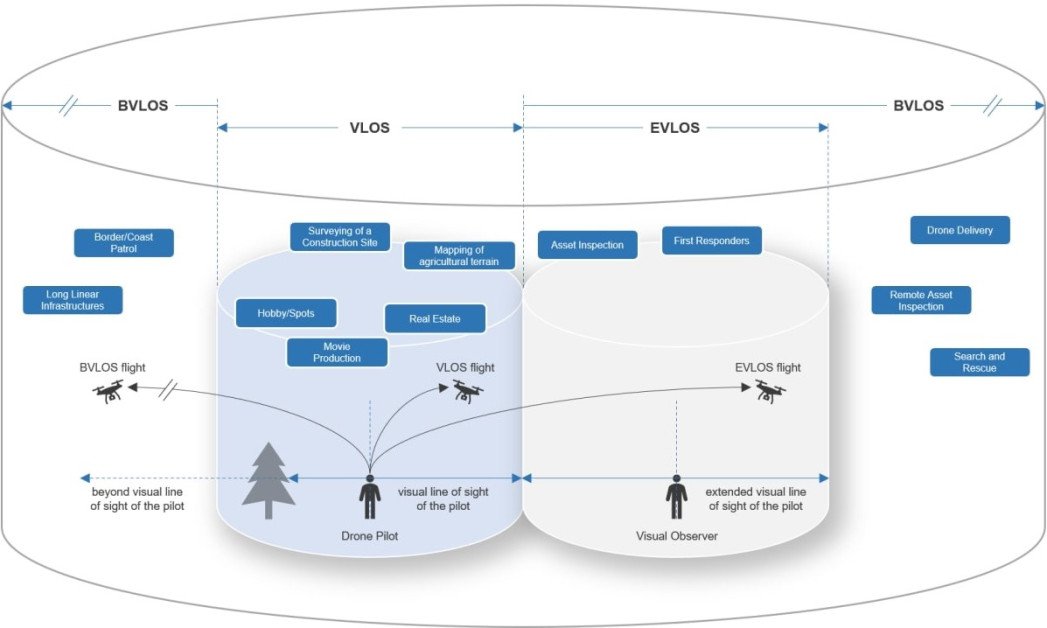
Definition
VLOS stands for Visual Line of Sight. It refers to the operation of a drone or unmanned aircraft where the pilot or observer maintains direct visual contact with the aircraft at all times, ensuring safe and effective control.
Relevance to the Industry
VLOS is a standard operational requirement in many jurisdictions for safety and regulatory compliance. It ensures that the pilot can see and avoid obstacles, other aircraft, and people, reducing the risk of accidents. Understanding and adhering to VLOS requirements is crucial for both hobbyist and commercial drone operators to conduct safe and lawful flights.
How Does VLOS Work?
Visual Line of Sight (VLOS) operations involve operating drones or unmanned aerial systems (UAS) within the direct visual range of the pilot. This method ensures that the operator can maintain visual contact with the aircraft at all times, providing a straightforward and safe approach to drone operations. Here’s an in-depth look at how VLOS works:
1. System Components
- Unmanned Aerial Vehicle (UAV): The drone itself, which can be a fixed-wing, rotary-wing (e.g., quadcopter), or hybrid aircraft.
- Ground Control Station (GCS): The control unit where the operator manages and monitors the UAV’s flight, typically using a handheld remote control or a computer-based interface.
- Communication Link: The data link that connects the UAV to the GCS, allowing for real-time transmission of telemetry data and control commands.
2. UAV Structure and Propulsion
- Airframe: The body of the UAV, designed to be lightweight yet durable, providing aerodynamic stability and housing all essential components.
- Propulsion System: Consists of electric motors and propellers that generate the necessary thrust for takeoff, flight, and maneuvers.
- Power Source: Typically rechargeable lithium-polymer (LiPo) batteries, supplying the energy required for flight operations.
3. Navigation and Control Systems
- Manual Control: The operator uses a remote control to directly maneuver the UAV. This involves adjusting the altitude, speed, and direction based on visual observations.
- Basic Autopilot Functions: Some VLOS drones may have basic autopilot capabilities, such as maintaining a stable hover, but the operator primarily controls the flight.
4. Communication Systems
- Data Link: Facilitates two-way communication between the UAV and the GCS, transmitting telemetry data (e.g., battery status, GPS coordinates) and receiving control inputs from the operator.
- Telemetry System: Provides real-time feedback on the UAV’s status, crucial for monitoring and ensuring safe operations.
5. Operational Phases
- Pre-Flight Preparation: The operator performs a pre-flight check, ensuring that the UAV is in good working condition, the batteries are fully charged, and the weather conditions are suitable for flight.
- Takeoff and Launch: The operator manually launches the UAV, ensuring it achieves a stable hover or initial flight path.
- Mission Execution: During the flight, the operator keeps the UAV within visual line of sight, directly controlling its movements and making real-time decisions based on visual cues.
- Data Collection or Task Performance: Depending on the mission, the UAV may capture images, videos, or other data. The operator ensures the UAV stays within the visual range and completes the required tasks.
- Landing and Recovery: The operator manually guides the UAV back to the landing zone, ensuring a safe and controlled descent and landing.
6. Applications and Use Cases
- Aerial Photography and Videography: Capturing high-quality images and videos for media production, real estate, and personal use.
- Recreational Flying: Hobbyists and enthusiasts flying drones for enjoyment and skill-building.
- Surveying and Mapping: Conducting surveys and creating maps of small areas, such as construction sites or agricultural fields.
- Inspection and Monitoring: Inspecting infrastructure, such as roofs, power lines, and bridges, within a limited range.
- Search and Rescue: Assisting in search and rescue operations by providing an aerial perspective in relatively small areas.
Understanding how VLOS operations work highlights the simplicity and safety of maintaining direct visual contact with the UAV. This method is ideal for short-range missions and recreational flying, ensuring that the operator has immediate control and awareness of the drone’s position and surroundings.
Example in Use
“Commercial drone pilots conducting real estate photography must operate within VLOS to comply with regulatory guidelines and ensure safety.”
VLOS and Its Role in Safety
Visual Awareness: Maintaining VLOS allows the pilot to have a continuous, unobstructed view of the drone, providing real-time awareness of its position, orientation, and movement. This visual feedback is crucial for maneuvering the drone safely and effectively, especially in environments with obstacles or dynamic conditions.
Obstacle Avoidance: VLOS ensures that the pilot can see and react to potential obstacles, such as trees, buildings, and power lines. This ability to visually detect and avoid obstacles significantly reduces the risk of collisions and accidents.
Airspace Awareness: Operating within VLOS allows the pilot to maintain awareness of other air traffic and comply with airspace regulations. It helps prevent airspace violations and reduces the risk of mid-air collisions with manned aircraft.
Regulatory Compliance: VLOS is often a legal requirement set by aviation authorities to ensure safe drone operations. Adhering to VLOS regulations helps operators avoid legal penalties and ensures that drone activities do not pose a risk to public safety.
Immediate Response: In case of an emergency or unexpected situation, maintaining VLOS enables the pilot to take immediate corrective action. This quick response capability is critical for mitigating risks and ensuring the safe operation of the drone.
Frequently Asked Questions about VLOS (Visual Line of Sight)
1. What is VLOS in drone operations?
Answer: VLOS (Visual Line of Sight) in drone operations means that the drone pilot or a designated observer must maintain direct, unaided visual contact with the drone at all times during flight. This ensures the pilot can see the drone’s position, orientation, and movement relative to obstacles, people, and other aircraft. It is a fundamental safety measure required by aviation authorities to prevent accidents and collisions.
2. Why is VLOS important?
Answer: VLOS is important because it:
- Enhances Safety: Ensures the pilot can see and avoid obstacles, other aircraft, and people.
- Regulatory Compliance: Meets legal requirements set by aviation authorities in many regions.
- Prevents Collisions: Allows for immediate response to unexpected situations, reducing the risk of mid-air collisions and ground accidents.
- Operational Control: Provides the pilot with real-time awareness of the drone’s environment and performance, ensuring precise and safe operation.
3. What are the limitations of VLOS?
Answer: The limitations of VLOS include:
- Range Restriction: Limits the operational range of the drone to the pilot’s visual capabilities, typically a few hundred meters.
- Operational Constraints: Requires clear visibility, which can be hindered by obstacles, weather conditions, and lighting.
- Resource Requirement: May require additional observers for operations over larger areas, increasing operational complexity and costs.
- Limited Applications: Restricts certain commercial and industrial applications that require extended range and coverage, necessitating BVLOS (Beyond Visual Line of Sight) capabilities for broader operations.
For examples of these acronyms visit our Industries page.
To determine your VLOS try our calculator.
As the CEO of Flyeye.io, Jacob Stoner spearheads the company's operations with his extensive expertise in the drone industry. He is a licensed commercial drone operator in Canada, where he frequently conducts drone inspections. Jacob is a highly respected figure within his local drone community, where he indulges his passion for videography during his leisure time. Above all, Jacob's keen interest lies in the potential societal impact of drone technology advancements.


